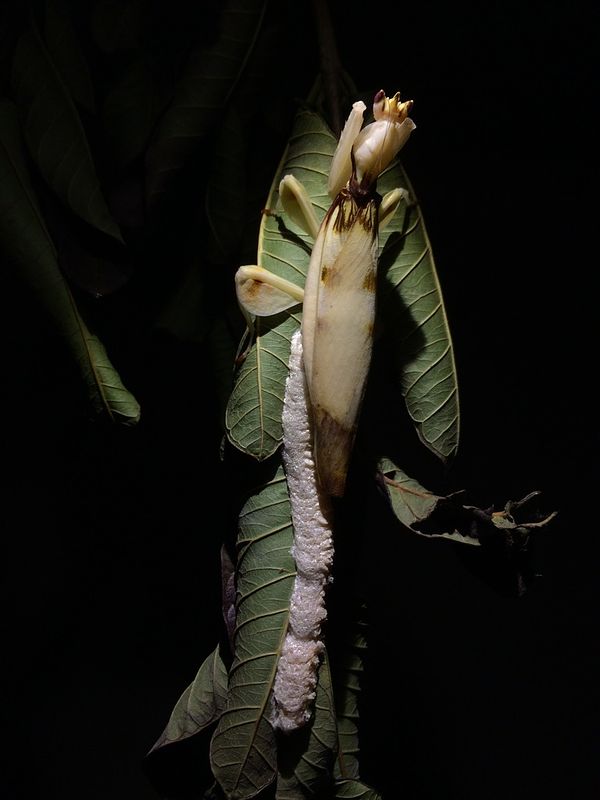Ranitomeya
Well-known member
I've noticed that many people tend to throw around the terms egg bound and egg binding when talking about female mantises that refuse to lay their oothecae. Egg binding is a term used for things like reptiles and birds where they do not have enough calcium or other minerals in their diet and either their muscles become unable to work properly due to the deficiency or their eggs are too soft and cannot be pushed out because they simply change shape in response to muscle contractions. It is a medical issue and not a behavior in most cases. The exception is in reptiles such as chameleons that will refuse to lay their eggs if not provided the right conditions and then die as they weaken--in that case it's a behavior that leads to being a medical issue.
Unless a mantis has some sort of genetic defect, physical malformation, or damaged parts, they cannot be egg bound without having some other health issue that would likely manifest in paralysis or decreased mobility due to weakness. A perfectly healthy female can simply refuse to lay eggs unless they are provided the proper location and conditions for oviposition. Refusal to lay eggs in any but the optimal location and condition is not uncommon in invertebrates--many butterflies and moths will refuse to produce a single egg unless they are given plant material that has the right chemical cues--a signal that if they lay their eggs, their offspring will not hatch out and starve or die due to incorrect or non-existent food material. It is not a sign of being egg bound, it's simply a sign that you need to change things up and try to provide the right kind of location and replicate the proper conditions for oviposition. Yes, some females will lay eggs without any regard for conditions--this is just variation in behavior within a species that allows them to increase the chance that at least some of the population might be able to exist in suboptimal conditions.
Here is my female Hymenopus coronatus that had finally laid its first ootheca. Two whole months after being well-fed enough that she did not eat much at feedings. She's been with a male since a couple weeks after molting into an adult and being seen calling. She was not egg bound, but simply did not like the surfaces provided in her enclosure. During the past two weeks, she's been wandering around her enclosure non-stop in an attempt to find the right place to oviposit. Once she was moved out of the enclosure and provided with a branch with large leaves that I hung over my desk, she stopped wandering after a day and stayed in the same relative position for another day before laying her ootheca.

These stories about mantises getting too fat too lay eggs and becoming egg bound are just that--stories. Natural selection does not select for maladaptive behaviors--only humans do that. If very well-fed female mantises could become incapable of laying oothecae, their species would rapidly go extinct, so natural selection would create species that would stop feeding in order to prevent females from becoming incapable of producing offspring.
Unless a mantis has some sort of genetic defect, physical malformation, or damaged parts, they cannot be egg bound without having some other health issue that would likely manifest in paralysis or decreased mobility due to weakness. A perfectly healthy female can simply refuse to lay eggs unless they are provided the proper location and conditions for oviposition. Refusal to lay eggs in any but the optimal location and condition is not uncommon in invertebrates--many butterflies and moths will refuse to produce a single egg unless they are given plant material that has the right chemical cues--a signal that if they lay their eggs, their offspring will not hatch out and starve or die due to incorrect or non-existent food material. It is not a sign of being egg bound, it's simply a sign that you need to change things up and try to provide the right kind of location and replicate the proper conditions for oviposition. Yes, some females will lay eggs without any regard for conditions--this is just variation in behavior within a species that allows them to increase the chance that at least some of the population might be able to exist in suboptimal conditions.
Here is my female Hymenopus coronatus that had finally laid its first ootheca. Two whole months after being well-fed enough that she did not eat much at feedings. She's been with a male since a couple weeks after molting into an adult and being seen calling. She was not egg bound, but simply did not like the surfaces provided in her enclosure. During the past two weeks, she's been wandering around her enclosure non-stop in an attempt to find the right place to oviposit. Once she was moved out of the enclosure and provided with a branch with large leaves that I hung over my desk, she stopped wandering after a day and stayed in the same relative position for another day before laying her ootheca.

These stories about mantises getting too fat too lay eggs and becoming egg bound are just that--stories. Natural selection does not select for maladaptive behaviors--only humans do that. If very well-fed female mantises could become incapable of laying oothecae, their species would rapidly go extinct, so natural selection would create species that would stop feeding in order to prevent females from becoming incapable of producing offspring.



